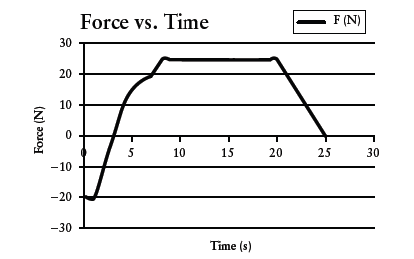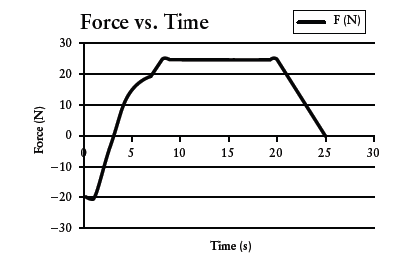
Concept explainers
(a)
A graph of force versus time.
Answer to Problem 36QAP
The graph of force versus time is as below: -

Explanation of Solution
Given info:

(b)
The speed of object after
Answer to Problem 36QAP
The speed of object after
Explanation of Solution
The area under a force versus time curve is equal to the change in momentum of the object.
We break the graph into different parts two obtain the area so that we can calculate the momentum of the object.
since the object starts from rest, we have initial velocity of the object as zero that gives initial momentum of the object equals to zero.
Conclusion:
The speed of object is
Want to see more full solutions like this?
Chapter 7 Solutions
COLLEGE PHYSICS
- The graph provided shows the force applied to a toy car (m = 5 kg) over some distance traveled. Force vs. Distance 9 00 8 7 6 Force (N) D 3 0 2 omis 2 8 10 Distance (m) 12 14 If the initial velocity of the car at d = 0 m was 10 m/s, what is the final velocity of the car at d = 16 18 m? 18arrow_forwardA constant force of 200N is required to accelerate a 1600 kg trailer from rest to a speed of 25m/s. How much distance is covered by the trailer in that duration? I keep getting 2500m but it is within the given answers.arrow_forwardmg = 6 kg Nhand,A = 75 N VA = 8 m/s ma = 3 kg Block Block Block Block B A Hx = 0.4 2 m- Ax Note: Diagram is not drawn to scale 75 N for a distance Ax 2 m along a (mostly) A hand pushes block A (m = 3 kg) with a constant force Nand, A frictionless table such that it speeds up from rest and is traveling at a speed of 8 m/s after it slides over a rough section of the table (u, = 0.4). Block A then collides with a more massive block B (m, = 6 kg) that is initially at rest. %3D Find Ax, the length of the rough section of the table. A) 1.0 m В) 15.4 m C) 4.5 m D) 7.5 m E) 2.6 m O A O Barrow_forward
- On a 119 meter high roller coaster is a 75 kg car at rest. Assuming there is no friction, what will its velocity be at the bottom? a) The car from the previous roller coaster begins its journey towards a second climb with a speed of 58 m / s. Assuming there is no friction, how high will it reach before stopping?arrow_forwardA runaway train car that has a mass of 1.68e+4 kg travels at a speed of 7.60 m/s down a track. Compute the time required for a force of 1.57e+3 N to bring the car to rest. a numerical answer below. Accepted formats are numbers or "e" based scientific notation e.g. 0.23, -2, 1e6, 5.23e-8 ....sarrow_forwardHow large a force is required to accelerate a 1600 kg car from rest to a speed of 30 m/s in a ?distance of 95 m 7.6 KN O 7.57*10^-3 KNO 7.6 *10^-3 KNO 7.6 *10^3 KNO 7.5 kN Oarrow_forward
- A bowling ball is dropped from the top of a building that has a height of h = 112 m. Part (a) Assuming air resistance is negligible, what is the ball's speed, vf in m/s, when it strikes the ground?Part (b) If drag produces an opposing force of 10 N while the ball's falling, what is the ball's speed, vf in m/s, when it strikes the ground? Assume the ball has a mass of 5 kg.Part (c) A different ball was dropped and the final speed was measured to be vf = 8.5 m/s while the drag force was measured to be 50 Newtons. What is the mass of this ball in kg?arrow_forwardThe only force acting on a 2.0-kg body moving along the x axis is given by Fx = 2x where force is measured in Newtons, N, and x is in meters. If the velocity of the object at x = 0 is +3.0 m/s, how fast is it moving at x = 2.0 m?arrow_forwardA 1000 kg object is rising. Its speed is increasing at 3 m / s2. The force on the object is:arrow_forward
- ФЫ В А ПРО В А ПРО ЛДЗАПРОЛДЖЭ ЯЧСМИТНЧСМИТЬБНСМИТЬБЮ SOLVE STEP BY STEP IN DIGITAL FORMAT 27.- A mechanic pushes a 2000Kg car from rest and reaches a speed of 3m/s with a constant horizontal force. During that time the car travels a distance of 30m neglecting the friction between the car and the ground, determine; a) the work done by the mechanic and b) the horizontal force exerted on the car. 28.- Express the kinetic energy of an electron moving at a speed of 106 m/s in ev. Repeat it for a proton. ИЦУКЕНГШУКЕНТ ШЩКЕНТ Ш ЩЗХЬarrow_forwardAn object of mass 380 kg is sliding on a track. From A to B, the track is frictionless. From B to C the coefficient of kinetic friction = 0.3. The velocity of the object at point A is m/s. It took the object 15 s to go from A to B. 1) 2) 3) 4) A 5) 6) Friction = 0 UB= m/s m B In the formula-sheet provided which equation can be used to calculate the length of the track AB, The length of the track AB C The magnitude of the normal force on track BC N S the magnitude of the kinetic friction force on track BC N How long will it take for the object to stop? Oarrow_forwardPhysics, 1le Itais Help | System Announcements PRINTER VERSION 4 ВАСK NEXT Chapter 07, Problem 084 Z Your answer is partially correct. Try again. A force F = (2.51 + 8.4 + 6.4k) N : acts on a 3.6kg object that moves in 2.3s from an initial position 1 = (3.4i + 3.6j + 3.2 3.28) m to a final position T2 = (5.3i + 4.0j + 8.2k ) m. Find (a) the work done on the object by the force in that time interval, (b) the average power due to the force during that time interval, and (c) the angle between the vectors T1 and T2. (a) Number Units (b) Number Units (c) Number Units (degrees) Click if you would like to Show Work for this question: Open Show Work SHOW HINT LINK TO TEXT LINK TO SAMPLE PROBLEM LINK TO SAMPLE PROBLEM MATH HELP VIDEO MINI-LECTURE Ouestio Attompte Unlinmited SAVE FOR LATER SUDMIT ANCWCN 9:09 PM ENG e to search 4/4/2021 ASUS pause break pgup prt sc insert de 17 horme Lend Pgdn 13) 23, boarrow_forward
 College PhysicsPhysicsISBN:9781305952300Author:Raymond A. Serway, Chris VuillePublisher:Cengage Learning
College PhysicsPhysicsISBN:9781305952300Author:Raymond A. Serway, Chris VuillePublisher:Cengage Learning University Physics (14th Edition)PhysicsISBN:9780133969290Author:Hugh D. Young, Roger A. FreedmanPublisher:PEARSON
University Physics (14th Edition)PhysicsISBN:9780133969290Author:Hugh D. Young, Roger A. FreedmanPublisher:PEARSON Introduction To Quantum MechanicsPhysicsISBN:9781107189638Author:Griffiths, David J., Schroeter, Darrell F.Publisher:Cambridge University Press
Introduction To Quantum MechanicsPhysicsISBN:9781107189638Author:Griffiths, David J., Schroeter, Darrell F.Publisher:Cambridge University Press Physics for Scientists and EngineersPhysicsISBN:9781337553278Author:Raymond A. Serway, John W. JewettPublisher:Cengage Learning
Physics for Scientists and EngineersPhysicsISBN:9781337553278Author:Raymond A. Serway, John W. JewettPublisher:Cengage Learning Lecture- Tutorials for Introductory AstronomyPhysicsISBN:9780321820464Author:Edward E. Prather, Tim P. Slater, Jeff P. Adams, Gina BrissendenPublisher:Addison-Wesley
Lecture- Tutorials for Introductory AstronomyPhysicsISBN:9780321820464Author:Edward E. Prather, Tim P. Slater, Jeff P. Adams, Gina BrissendenPublisher:Addison-Wesley College Physics: A Strategic Approach (4th Editio...PhysicsISBN:9780134609034Author:Randall D. Knight (Professor Emeritus), Brian Jones, Stuart FieldPublisher:PEARSON
College Physics: A Strategic Approach (4th Editio...PhysicsISBN:9780134609034Author:Randall D. Knight (Professor Emeritus), Brian Jones, Stuart FieldPublisher:PEARSON





